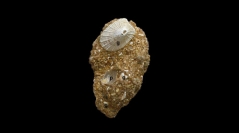

 Comptes Rendus Palevol
6 (1-2) - Pages 59-71
Comptes Rendus Palevol
6 (1-2) - Pages 59-71Two kinds of bioaccumulations are particularly abundant in the Upper Miocene and the Pliocene from western Europe. On the one side, the ‘faluns’ constitute noticeable fossiliferous accumulations in the Miocene and the Pliocene of western France. On the other side, the algal limestones from the western Mediterranean basin developed a lot from the Uppermost Tortonian to the Lower Pliocene. The comparison between these different bioaccumulations, first between facies of the same group but of different geological ages, then between the two kinds of facies allows us to point out numerous faunal and palaeoenvironmental similarities, but fundamental differences too. Therefore, the Tortonian « faluns » from western France are more similar, from a palaeontological viewpoint, to the different Mediterranean algal limestones than they are to younger Messinian and Pliocene ‘faluns’. Moreover, the algal limestones from the Messinian are more similar to those of the Pliocene than they are to the Uppermost Tortonian ones, marked by a greater abundance of Rhodophycea and a lower benthic invertebrate diversity. The subtropical character of the Tortonian ‘faluns’ and of the different algal limestones is opposed to the cooler character of the Messinian and Pliocene ‘faluns’, marked by the development of marsupiate echinoids (Coptechinus, Temnechinus, Temnotrema). In the western Mediterranean, the faunal renewal after the Messinian crisis is low, diverse endemic species (Clypeaster altus, Schizaster saheliensis) surviving in the successive algal limestones of the Messinian and the Pliocene. Thus, the contribution of the East-Atlantic macrofauna coming from the ‘Faluns Sea’ to the Pliocene reconquest of the western Mediterranean basin appears much reduced.
Faluns, algal limestones, bioaccumulations, messinian crisis, Mio-Pliocene